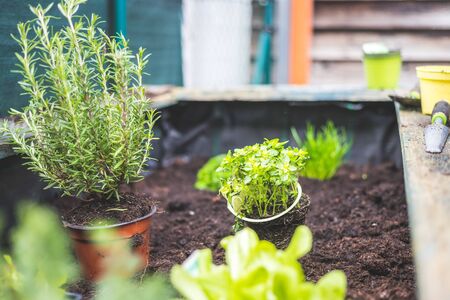Introduction to Space-saving Borders in Indian Home Gardens
In today’s rapidly urbanising India, space is a precious commodity, especially for gardening enthusiasts living in cities like Mumbai, Bengaluru, or Delhi. Many homeowners dream of having a green haven, but are limited by compact balconies, terraces, or small backyard spaces. This is where the concept of space-saving garden borders comes into play. Traditionally, Indian gardens have embraced sprawling lawns and lush flowerbeds as part of our cultural landscape. However, with shrinking living spaces and the rise of apartment living, there is a growing need to rethink garden design—making every inch count while maintaining aesthetic charm. Compact borders not only help define garden areas clearly but also maximise planting opportunities and keep gardens organised without feeling cluttered. As more Indians embrace sustainable lifestyles and reconnect with nature at home, exploring creative and practical border ideas tailored for small spaces has become both essential and exciting.
2. Upcycling and Local Materials for Border Creation
When space is limited in Indian home gardens, using upcycled and locally available materials for garden borders not only helps save space but also supports sustainable gardening practices. Many Indian households have easy access to traditional materials such as terracotta pots, old bricks, bamboo stalks, and coconut shells. These items can be creatively repurposed into charming garden borders that reflect local culture and help the environment.
Terracotta Pots: A Traditional Touch
Broken or unused terracotta pots are a common sight in Indian homes. Instead of discarding them, you can partially bury the pots along the edge of your garden beds to form a rustic border. Their earthy colour blends beautifully with Indian landscapes and they allow water to seep through, preventing puddles during monsoon season.
Bricks: Durable and Versatile
Old bricks salvaged from renovation or construction sites can be stacked vertically or laid flat to create neat and long-lasting borders. Bricks are easy to arrange in curves or straight lines, making them ideal for small, irregularly shaped spaces found in many urban Indian gardens.
Bamboo: Natural and Flexible
Bamboo grows abundantly across India and is both strong and flexible. Thin bamboo poles can be cut to size and woven together or placed upright in the soil for a low-cost, eco-friendly fence that keeps soil in place while adding a touch of greenery.
Coconut Shells: Eco-Friendly Innovation
Coconut shells, often discarded after use, make excellent mini-barriers for flower beds or herb patches. Simply halve the shells and line them up around plantings. This not only recycles kitchen waste but also gives your garden an authentic South Indian feel.
Comparison Table: Local Materials for Garden Borders
| Material | Availability | Durability | Cultural Relevance | Space-saving Value |
|---|---|---|---|---|
| Terracotta Pots | High | Moderate | Traditional Indian gardens | Excellent for narrow edges |
| Bricks | Very High | High | Common in Indian homes | Good for compact layouts |
| Bamboo | Regionally abundant | Moderate to High | Northeast & South India | Flexible for curved spaces |
| Coconut Shells | High (coastal areas) | Moderate | Tropical/South India vibe | Perfect for tiny beds/pots |
Practical Tips:
- Sterilise recycled materials before use to prevent pests.
- If possible, paint or seal bricks/bamboo for longer life, especially during monsoons.
- Mingle different materials for a colourful, textured look reflecting India’s diversity.
- Create interactive edges by leaving gaps for herbs or trailing plants between borders.
This approach not only maximises your gardening space but also celebrates Indian ingenuity by turning everyday items into beautiful, functional features for your home garden.

3. Vertical and Layered Border Solutions
When space is at a premium in small Indian home gardens, thinking vertically can unlock surprising potential. Vertical planters are an excellent solution for homes in cities like Mumbai, Bengaluru, or Chennai where ground space is limited but sunlight often streams onto balconies or boundary walls. You can use hanging pots, stackable grow bags, or even recycled plastic bottles to create a lush green border that climbs upwards instead of spreading out.
Wall-Attached Borders
Attaching borders directly to walls is another smart move. In many Indian homes, courtyard or backyard walls remain unused. By installing wall-mounted racks or lattice frames, you create a tidy boundary that also showcases your favourite herbs and flowering plants. This approach works especially well for popular choices like tulsi (holy basil), money plant, or marigold — all of which thrive in Indian climates and hold cultural significance.
Tiered Layouts for Layered Greenery
If you have some width but want to maximise every inch, tiered garden borders are worth considering. Using steps made from bricks, bamboo, or recycled wood, you can arrange plants on different levels — a traditional trick seen in many South Indian homes. This not only saves space but also allows you to group plants by their sunlight needs: shade-loving greens below and sun-loving blossoms above.
Community Tip:
Many gardening enthusiasts in India swap cuttings and ideas at local events. Try collaborating with your neighbours to share materials for vertical setups or split the cost of sturdy wall brackets!
4. Edible and Herbal Border Plants for Indian Kitchens
When you think of space-saving garden border ideas for small Indian home gardens, edible and herbal plants are a practical and sustainable choice. These multi-purpose plants not only define your garden’s edge but also bring fresh flavours and health benefits straight to your kitchen. Here are some popular Indian kitchen essentials that work brilliantly as border plants:
Tulsi (Holy Basil)
Tulsi is revered in many Indian households for its spiritual significance and medicinal properties. Planting tulsi along the borders provides a natural air purifier, attracts pollinators, and ensures you have fresh leaves for chai or kadha at any time.
Curry Leaves (Kadi Patta)
Curry leaves are a staple in Indian cooking, adding aroma and flavour to countless dishes. As a low-maintenance shrub, curry leaf plants form lush green borders that require minimal space and offer year-round harvests.
Lemongrass
Lemongrass grows upright and dense, making it perfect for creating structured garden edges. Its citrusy aroma keeps pests away, while the leaves can be used in tea, soups, or chutneys.
Comparison Table: Edible Border Plants for Small Gardens
| Plant Name | Main Use in Kitchen | Growth Habit | Space Required | Additional Benefits |
|---|---|---|---|---|
| Tulsi (Holy Basil) | Tea, herbal remedies | Bushy, compact | Low to moderate | Air purification, spiritual value |
| Curry Leaves (Kadi Patta) | Tempering curries & dals | Shrubby, perennial | Moderate | Aromatic foliage, pest repellent |
| Lemongrass | Tea, flavouring dishes | Tall, clumping grass | Narrow strip along borders | Pest control, fragrant garden edge |
Tips for Maximising Space with Herbal Borders:
- Select herbs that thrive in your local climate and soil conditions.
- Stagger planting so you can harvest different herbs throughout the year.
- Use raised beds or narrow strips to create defined borders without sacrificing growing area.
- Regularly trim and prune to maintain a neat appearance and encourage bushier growth.
- Combine herbs with companion flowering plants like marigold or ajwain to enhance both beauty and utility.
By integrating edible and herbal plants into your garden borders, you make the most out of every inch of available space while supporting a healthy lifestyle rooted in Indian traditions.
5. Maintenance Tips for Small-space Borders
Keeping your small garden borders neat and healthy can be simple, even with a busy Indian lifestyle. Here are practical tips that suit both the local climate and your daily routine:
Watering Wisely
In many parts of India, summers can be harsh and water scarcity is common. To save time and water, install a simple drip irrigation system or use clay pot (matka) watering methods. Water early in the morning or late in the evening to reduce evaporation. Group plants with similar water needs together to avoid overwatering.
Pest Control Made Easy
Avoid chemical pesticides by choosing natural options like neem oil spray or homemade garlic-chilli solutions, which are safe for children and pets. Encourage beneficial insects like ladybirds and use marigolds as border plants to naturally repel pests.
Mulching for Less Work
Cover your soil with dry leaves, coconut husk chips, or straw—materials easily available in Indian markets. Mulching helps retain moisture, suppresses weeds, and keeps roots cool during hot spells.
Regular Upkeep without Hassle
Set aside 10-15 minutes twice a week for quick tasks like removing dried leaves, checking plant health, and pruning excess growth. Involve family members to make it a fun routine!
Seasonal Adjustments
Adapt your care schedule according to monsoon, winter, or summer. For example, check drainage during rains to avoid root rot, and shield delicate plants from strong winds using bamboo screens or recycled plastic bottles.
Community Sharing and Learning
Connect with neighbours or local gardening groups on WhatsApp or Facebook to exchange tips about what works best in your area’s unique conditions. Sharing experiences helps everyone maintain beautiful garden borders effortlessly.
6. Community-driven Garden Border Ideas
In the context of Indian culture, gardening is not just an individual pursuit—it is often a collective activity that brings together families and communities. When you are looking for space-saving garden border ideas for small Indian home gardens, leveraging the strength of community can lead to innovative and sustainable solutions.
Encouraging Shared Local Resources
Indian localities are rich in shared resources such as stone, bamboo, terracotta, and even upcycled materials like broken tiles or bricks. By pooling these locally available items, neighbours can collectively create beautiful, cohesive borders for their home gardens. For example, organizing a neighbourhood drive to collect unused pots or stones can help everyone save money while also reducing waste.
Family Involvement in Border Creation
Gardening can become a bonding activity for Indian families. Involve children and elders alike in designing and building garden borders. Children can paint rocks or old bricks with traditional motifs, while elders might share tips on natural arrangements or indigenous plants suitable for borders. This intergenerational exchange strengthens family ties and preserves gardening knowledge.
Collective Practices: The Indian Way
Many Indian societies practice group activities such as community clean-ups or festival decorations. Similarly, forming small garden clubs within your apartment complex or colony can make border creation easier and more enjoyable. Members can rotate tools, share plants, and help each other set up compact yet attractive borders that reflect local aesthetics—like using rangoli patterns with pebbles along the edges or repurposing clay diyas after festivals.
By tapping into community spirit and collective wisdom, even the smallest Indian home gardens can have borders that are practical, beautiful, and deeply rooted in local tradition.
7. Showcasing Indian Success Stories and Inspirations
Across India, innovative gardeners have transformed small spaces into lush retreats by creatively managing their garden borders. Let’s explore some inspiring examples from different regions that demonstrate how space-saving ideas can be adapted to suit local needs and styles.
Mumbai: Vertical Herb Borders in Balcony Gardens
In the bustling city of Mumbai, where every inch counts, Mrs. Asha Patel converted her compact balcony into a productive green zone. She used stackable terracotta pots along the border to grow herbs like coriander, mint, and curry leaves. This not only maximized her vertical space but also added a fragrant, functional edge to her garden.
Bengaluru: Bamboo Edging for Eco-Friendly Borders
Mr. Suresh Rao in Bengaluru crafted his small backyard border with locally sourced bamboo. By weaving thin bamboo sticks into low fences, he created flexible borders that outline flower beds and vegetable patches. This approach is sustainable, cost-effective, and blends beautifully with the natural surroundings.
Kolkata: Recycled Brick Patterns for Classic Charm
The Sen family in Kolkata reused old bricks from a demolished wall to design a charming zigzag border around their tiny courtyard garden. The recycled bricks not only saved money but also gave their space a classic Bengali touch while neatly separating the flowering plants from the walking path.
Pune: Painted Stone Borders for Vibrant Touch
Inspired by Warli art, Ms. Rina Deshmukh painted stones with traditional motifs and arranged them as a colorful border around her kitchen garden. This DIY project brought vibrancy to her home while celebrating local art forms—proving that garden borders can be both practical and culturally expressive.
Community Inspiration: Sharing Ideas Across India
These stories show that with creativity and resourcefulness, even the smallest Indian gardens can have striking, space-saving borders. Whether you use recycled materials, embrace local crafts, or experiment with vertical arrangements, your efforts contribute to a growing community of urban gardeners inspiring one another across the nation.


